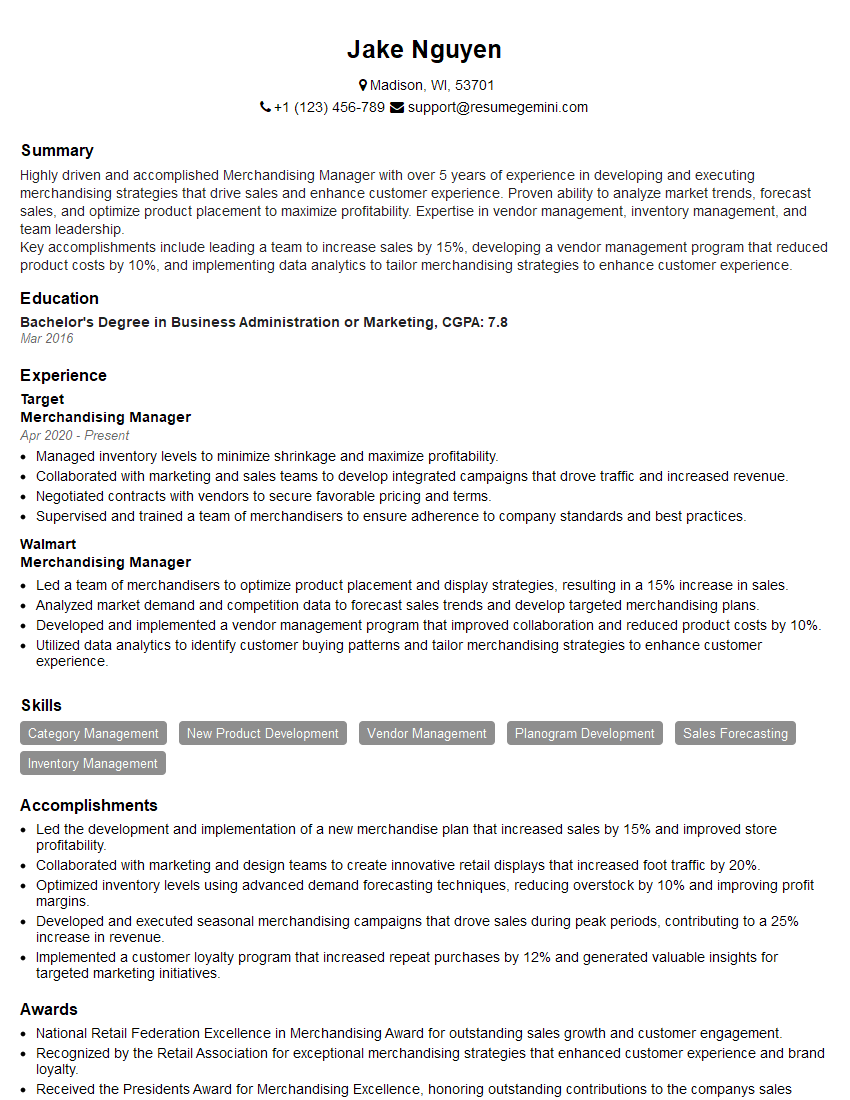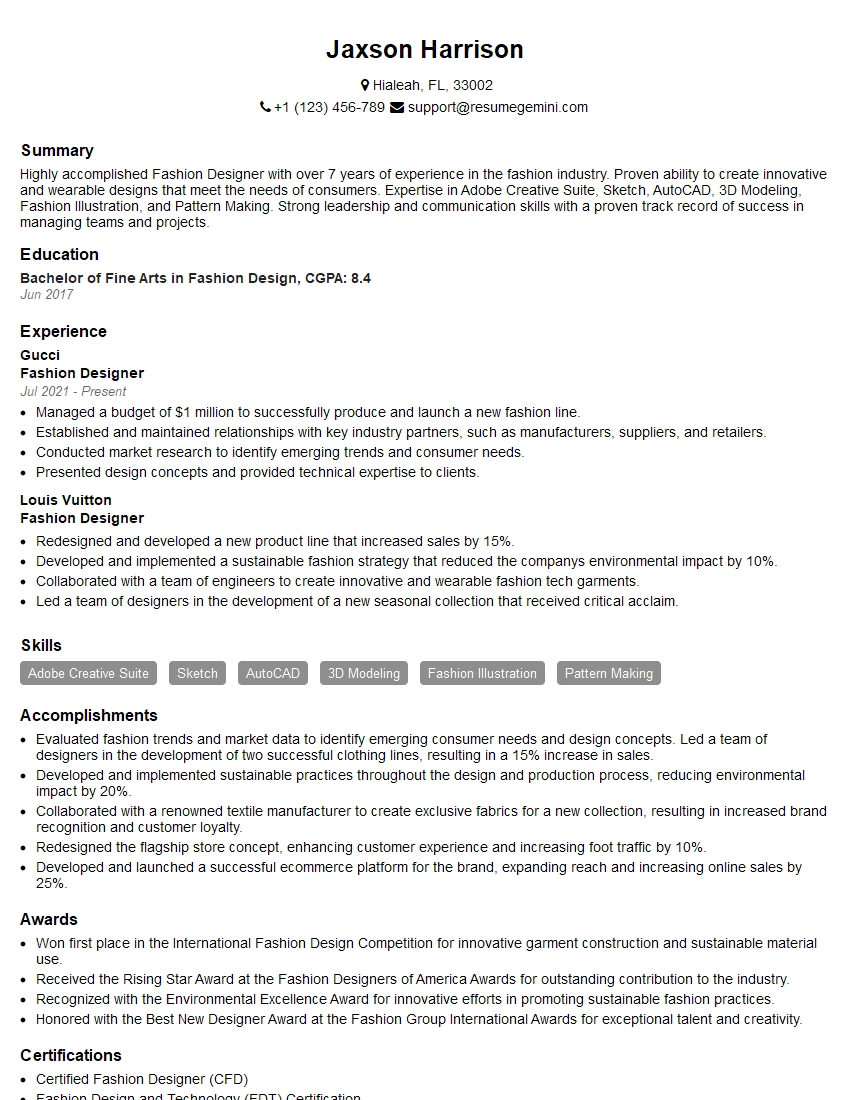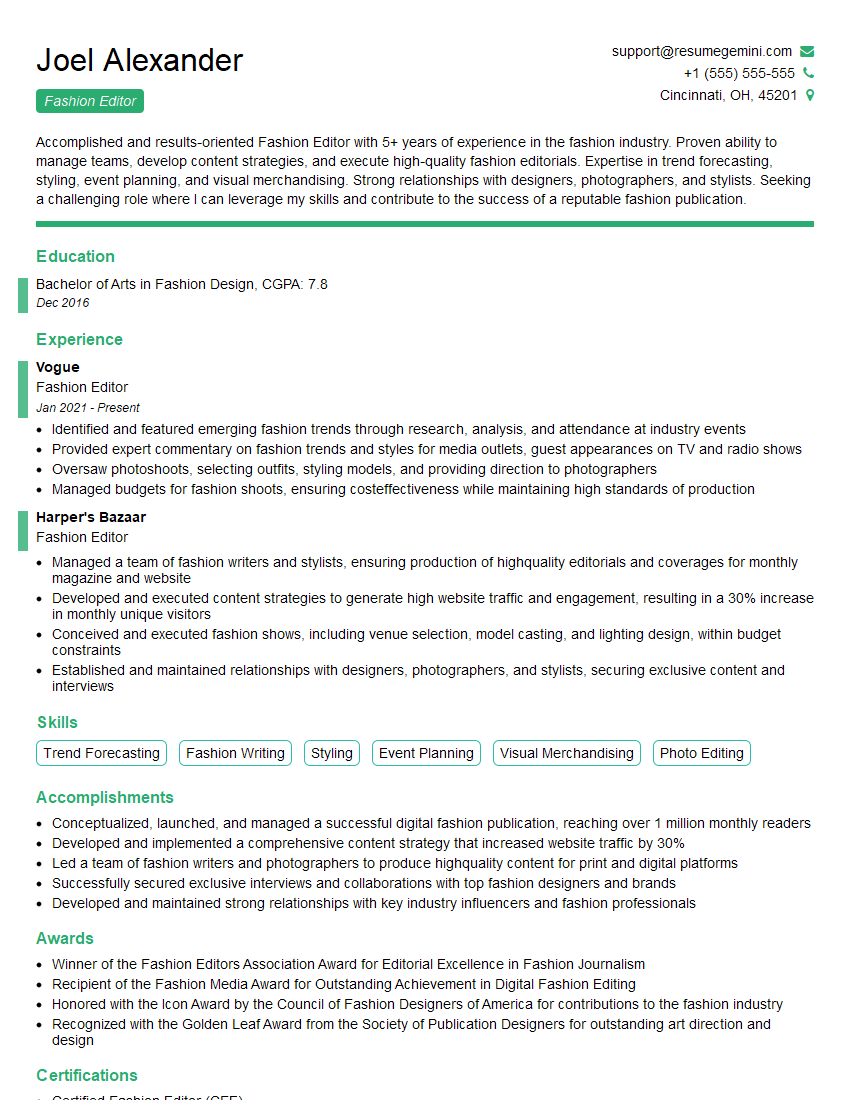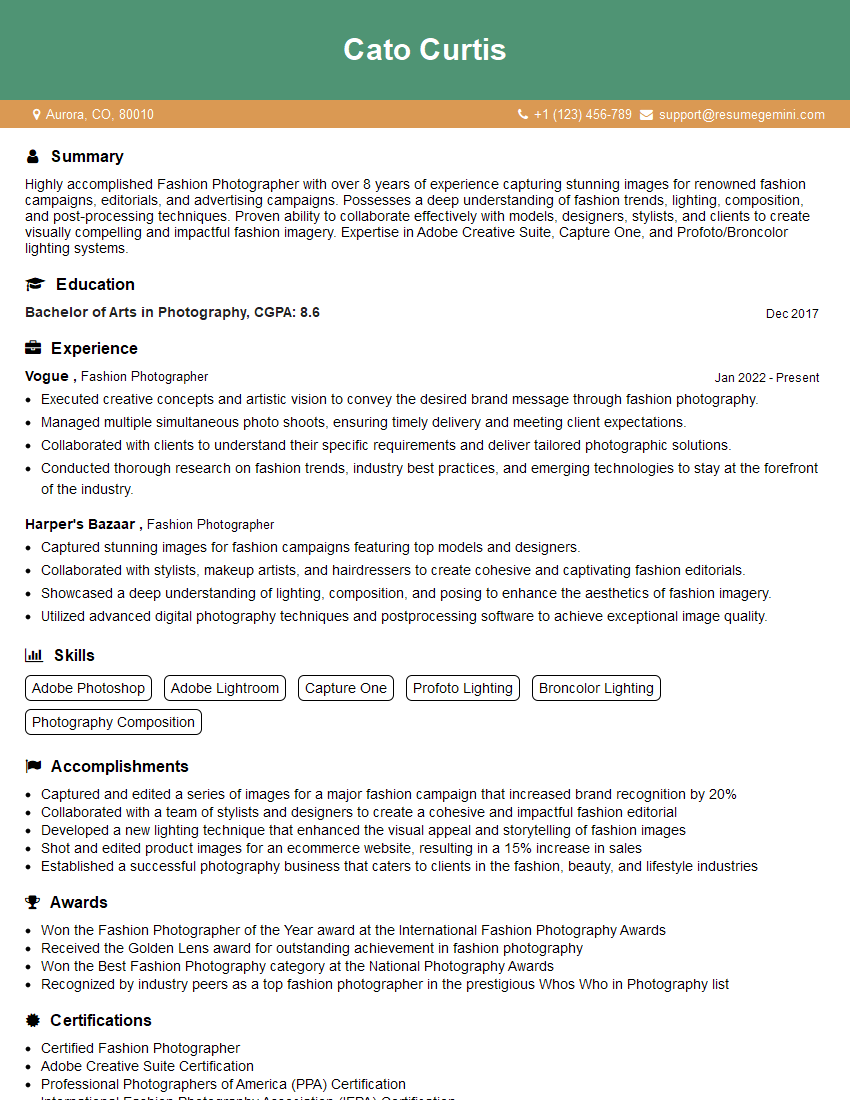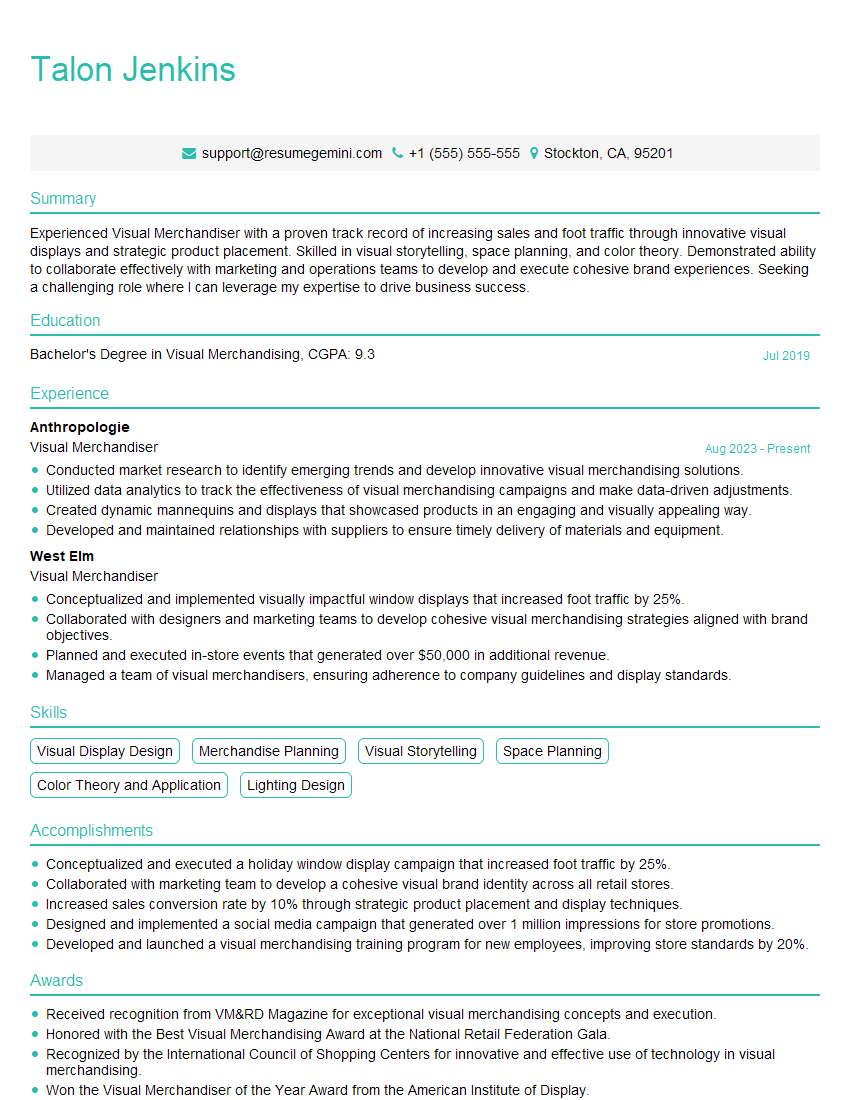The right preparation can turn an interview into an opportunity to showcase your expertise. This guide to Fashion Business and Marketing interview questions is your ultimate resource, providing key insights and tips to help you ace your responses and stand out as a top candidate.
Questions Asked in Fashion Business and Marketing Interview
Q 1. Explain your understanding of the current fashion market trends.
The current fashion market is incredibly dynamic, characterized by several key trends. Sustainability is paramount; consumers are increasingly demanding eco-friendly materials and ethical production practices. This translates to a rise in upcycled fashion, conscious brands, and transparent supply chains. Simultaneously, we see a strong personalization trend, with brands focusing on inclusive sizing, body positivity, and offering customized products or experiences. Technology plays a huge role, with virtual try-ons, personalized recommendations powered by AI, and the metaverse impacting the shopping experience. Finally, there’s a continued focus on experience, moving beyond just the product to create engaging brand stories and community around the brand. For example, brands are using immersive pop-up shops, collaborations with influencers, and interactive digital content to connect with customers on a deeper level. The rise of ‘quiet luxury’ is also notable, emphasizing understated elegance and high-quality craftsmanship over overt branding.
Q 2. Describe your experience with digital marketing strategies in the fashion industry.
My experience with digital marketing in fashion encompasses a wide range of strategies. I’ve successfully managed social media campaigns across various platforms, leveraging organic content and paid advertising to increase brand awareness and drive sales. I’ve implemented SEO (Search Engine Optimization) strategies to improve organic search rankings, resulting in higher website traffic. Email marketing has been a key focus, with personalized campaigns segmented by customer preferences and purchase history, boosting customer engagement and retention. I have also worked extensively with influencer marketing, partnering with relevant influencers to create authentic and engaging content. For example, for a sustainable footwear brand, we partnered with ethical fashion influencers to create Instagram Reels showcasing the shoes’ eco-friendly attributes and durability. Data analytics were crucial throughout; we used Google Analytics and other tools to track campaign performance and continuously optimize strategies.
Q 3. How would you develop a marketing campaign for a new clothing line?
Developing a marketing campaign for a new clothing line involves a strategic, phased approach. First, we’d define the target audience – their demographics, psychographics, lifestyle, and shopping habits. Next, we’d establish clear marketing objectives – are we focusing on brand awareness, lead generation, or immediate sales? The chosen marketing channels would directly align with the target audience and objectives. For instance, a younger audience might respond well to TikTok and Instagram, while a more mature audience could be reached effectively through email marketing and print advertising. The campaign messaging needs to be compelling, authentic, and resonate with the target audience. The creative assets – visuals, videos, copy – must reflect the brand’s aesthetic and the clothing line’s unique selling points. We would then determine the budget allocation across different channels, ensuring optimal resource distribution. Finally, we’d implement a robust tracking and analysis system to monitor campaign performance and make data-driven adjustments along the way. A key element would be a clear call to action across all channels, guiding customers towards the desired outcome (e.g., visiting the website, making a purchase).
Q 4. What metrics would you use to measure the success of a fashion marketing campaign?
Measuring the success of a fashion marketing campaign requires a multifaceted approach, utilizing key performance indicators (KPIs). Website traffic (unique visitors, bounce rate, time on site) indicates the campaign’s reach and engagement. Conversion rates (website visitors who make a purchase) directly measure sales effectiveness. Social media engagement (likes, shares, comments) reflects the campaign’s resonance with the target audience. Brand awareness metrics (brand mentions, social media sentiment) track changes in brand perception. Customer acquisition cost (CAC) determines the cost-effectiveness of acquiring new customers. Return on investment (ROI) provides the overall profitability of the campaign. For example, a successful campaign might show a significant increase in website traffic, high conversion rates, positive social media sentiment, and a healthy ROI.
Q 5. How do you stay updated on fashion trends and industry news?
Staying updated on fashion trends and industry news is crucial. I subscribe to leading fashion publications like Vogue, WWD, and Harper’s Bazaar, both in print and digital formats. I actively follow key fashion influencers and industry experts on social media platforms like Instagram and LinkedIn. I regularly attend industry events, fashion weeks, and trade shows to network and observe firsthand the latest trends. I also utilize market research reports from companies like Statista and McKinsey to gain insights into consumer behavior and market dynamics. Furthermore, I use trend forecasting tools and analyze competitor activity to anticipate upcoming trends and adapt my strategies accordingly.
Q 6. Describe your experience with social media marketing for fashion brands.
My experience with social media marketing for fashion brands includes creating and executing strategies across platforms like Instagram, Facebook, Pinterest, and TikTok. I have a strong understanding of each platform’s unique algorithm and user demographics. For instance, Instagram is ideal for visually driven content, emphasizing high-quality images and videos, while TikTok allows for short, engaging video content that leverages trending sounds and challenges. I leverage user-generated content to increase authenticity and engagement. Paid social media advertising campaigns are a core part of my approach, utilizing targeted advertising to reach specific demographics and interests. I use analytics dashboards to track campaign performance and continually optimize ad targeting and creative assets. For a recent project, we saw a significant increase in brand awareness and website traffic through a targeted Instagram campaign featuring user-generated content and engaging influencer collaborations.
Q 7. How would you handle a crisis in public relations for a fashion brand?
Handling a public relations crisis for a fashion brand requires a swift and decisive response. The first step is to swiftly assess the situation, identifying the root cause of the crisis and its potential impact on the brand’s reputation. Next, a crisis communication plan should be activated, including assembling a dedicated crisis team and establishing clear communication channels. Transparency is key; we must acknowledge the issue, express empathy, and provide accurate information. Depending on the nature of the crisis, we might issue a public apology, offer compensation, or take corrective action. It’s vital to actively monitor social media and other channels for public sentiment and address concerns promptly. The goal is to regain public trust and mitigate further damage to the brand’s reputation. Throughout the crisis, maintaining open communication with stakeholders, including customers, media, and employees, is essential. A post-crisis review should be conducted to identify lessons learned and improve future crisis management strategies. For example, if a product defect is discovered, we’d immediately issue a recall, communicate openly with customers, and offer replacement products or refunds.
Q 8. Explain your understanding of the fashion supply chain.
The fashion supply chain is a complex network of interconnected businesses and processes involved in getting a garment from raw material to the end consumer. Think of it as a relay race, with each stage passing the baton to the next.
- Raw Material Sourcing: This involves obtaining fabrics, trims, and other materials from suppliers, often globally dispersed.
- Manufacturing: This stage encompasses pattern making, cutting, sewing, and finishing of garments. It can be done in-house or outsourced to factories, often in different countries depending on cost and expertise.
- Distribution: Once manufactured, garments are transported to warehouses and distribution centers.
- Retail: This is where the garments are sold to the end consumer, either through brick-and-mortar stores, online platforms, or a combination of both.
- Logistics: This crucial element encompasses all aspects of transportation, warehousing, and inventory management throughout the entire process.
Understanding the fashion supply chain is critical for efficient production, cost management, and ethical considerations. For example, a brand might choose to source materials locally to reduce its carbon footprint or work with factories that adhere to fair labor practices. A thorough grasp of the chain allows for improved decision-making at each stage, leading to greater profitability and a positive brand image.
Q 9. How would you analyze sales data to inform future marketing decisions?
Analyzing sales data to inform future marketing decisions is crucial for success. I utilize a multi-faceted approach.
- Identify Trends: I start by analyzing sales figures over different time periods (daily, weekly, monthly, yearly) to identify best-selling products, peak sales periods, and slow periods. This helps reveal trends in customer preferences.
- Segmentation: I break down sales data by customer demographics (age, gender, location) and purchasing behavior (frequency, average order value, preferred payment methods) to understand different customer segments. This allows targeted marketing campaigns.
- Marketing Channel Performance: I analyze sales attributed to each marketing channel (e.g., website, social media, email marketing) to determine their effectiveness and ROI (Return on Investment). This helps allocate marketing budgets efficiently.
- Product Performance: I analyze sales data at the product level to identify which items are performing well and which are underperforming. This can inform decisions about inventory management, pricing, and future product development.
- Predictive Modeling: I utilize statistical models and forecasting techniques to predict future sales based on historical data and external factors (e.g., seasonality, economic conditions). This helps with inventory planning and resource allocation.
For example, if we see a significant increase in sales of sustainable clothing within a specific demographic, we can tailor future marketing campaigns to emphasize that aspect of our brand.
Q 10. Describe your experience with fashion merchandising and visual merchandising.
My experience in fashion merchandising and visual merchandising encompasses both strategic planning and hands-on execution. Merchandising involves planning and managing the product assortment to maximize sales, while visual merchandising focuses on creating an appealing store environment to enhance the shopping experience.
- Merchandising: I’ve been involved in selecting product lines, forecasting demand, managing inventory levels, and analyzing sales data to optimize pricing and promotions. I have experience working with different retail formats, from high-end boutiques to online marketplaces.
- Visual Merchandising: I have a strong understanding of store layout, window displays, and in-store signage. I’ve worked to create visually compelling displays that enhance brand identity and drive sales. This involves understanding color palettes, lighting, and spatial arrangement to maximize the impact of the products on display. I’ve also incorporated digital elements, such as interactive screens and QR codes, to enrich the shopping experience.
For instance, in a previous role, I reorganized a store’s layout, incorporating more lifestyle displays to showcase product coordination and increase average transaction value. The result was a significant increase in sales within a few months.
Q 11. What is your experience with budgeting and forecasting in a fashion business context?
Budgeting and forecasting are crucial for managing a fashion business effectively. It involves projecting future revenue and expenses, allocating resources, and monitoring performance against the budget.
- Revenue Forecasting: This involves estimating future sales based on historical data, market trends, and planned marketing initiatives. I use various forecasting methods, including time-series analysis and regression models.
- Expense Budgeting: This includes allocating funds for various aspects of the business, such as production costs, marketing expenses, salaries, and rent. I utilize zero-based budgeting to carefully examine all expenditures.
- Profitability Analysis: I analyze the projected revenue and expenses to determine profitability and identify areas for cost optimization.
- Variance Analysis: I regularly monitor actual performance against the budget to identify any significant variances and take corrective actions.
For example, during peak season, I would allocate a larger portion of the marketing budget to digital advertising, while during off-season, I might focus on email marketing and public relations to maintain brand awareness without overspending.
Q 12. How would you segment your target audience for a particular fashion product?
Segmenting the target audience is key to effective marketing. For a particular fashion product, I’d use a multi-dimensional approach.
- Demographic Segmentation: This involves dividing the market based on factors such as age, gender, income, education, occupation, and family status.
- Geographic Segmentation: This considers location, climate, and cultural influences, tailoring marketing efforts to specific regions.
- Psychographic Segmentation: This delves into lifestyle, values, attitudes, interests, and personality traits. This helps tailor marketing messages that resonate with specific values (e.g., sustainability, luxury).
- Behavioral Segmentation: This examines customer behavior, including purchasing patterns, brand loyalty, and usage frequency. This helps identify high-value customers and tailor offerings to their preferences.
For example, if launching a new line of sustainable activewear, I might target young, environmentally conscious women aged 25-40 with a high disposable income in urban areas who are active on social media and value ethical brands. This allows for highly targeted advertising and content creation.
Q 13. What is your experience working with influencers or celebrities?
I have extensive experience collaborating with influencers and celebrities, understanding that successful partnerships require strategic planning and careful execution.
- Influencer Selection: I identify influencers whose audience aligns with our target market and whose values and image complement our brand. This includes analyzing their engagement rates, audience demographics, and past collaborations.
- Campaign Development: I develop compelling campaign concepts that leverage the influencer’s unique style and reach. This ensures authenticity and resonates with their followers.
- Content Creation: I collaborate with influencers on content creation, ensuring alignment with our brand guidelines and campaign objectives. This could involve product reviews, social media posts, or even the creation of co-branded merchandise.
- Performance Measurement: I track campaign performance using key metrics like website traffic, sales conversions, and social media engagement. This ensures that our efforts are resulting in a positive return on investment.
For instance, I once worked with a micro-influencer on a campaign focused on sustainability. The campaign resulted in a 20% increase in sales of our eco-friendly line, demonstrating the power of authentic partnerships with the right influencers.
Q 14. How would you handle negative customer reviews or feedback?
Negative customer reviews and feedback, while unwelcome, present valuable opportunities for improvement and brand enhancement. My approach is proactive and focused on transparency and customer satisfaction.
- Monitor Reviews: I systematically monitor online reviews and social media mentions, using tools to track brand sentiment.
- Respond Promptly: I respond promptly and professionally to negative reviews, acknowledging the customer’s concerns and expressing empathy. A timely and genuine response shows that we value their feedback.
- Offer Solutions: I aim to offer concrete solutions to address the customer’s issues, whether it’s a refund, replacement, or a sincere apology.
- Learn and Improve: I analyze negative feedback to identify recurring issues and areas for improvement. This information can inform product development, customer service protocols, or marketing strategies.
- Publicly Address Issues (When Appropriate): For widespread issues, I might publicly address them through a blog post, social media announcement, or press release, demonstrating transparency and a commitment to customer satisfaction.
For example, if a significant number of customers complain about the sizing of a garment, I’d use this feedback to review our sizing chart and potentially adjust our manufacturing process to offer better fit options in the future.
Q 15. Explain your experience with e-commerce platforms and strategies.
My experience with e-commerce platforms encompasses strategy development, platform selection, and performance optimization. I’ve worked extensively with Shopify, Magento, and WooCommerce, each offering unique strengths for different business models. For instance, Shopify’s ease of use is ideal for smaller brands focusing on rapid growth, while Magento provides greater scalability and customization for larger enterprises. My strategies always begin with a thorough market analysis to identify the target audience and competitive landscape. This informs decisions about platform choice, marketing channels (SEO, PPC, social media), and inventory management. I’ve successfully implemented A/B testing on landing pages to optimize conversion rates, utilizing data analytics to track key performance indicators (KPIs) like customer acquisition cost (CAC) and average order value (AOV). A recent project involved migrating a brand from a legacy platform to Shopify, resulting in a 30% increase in sales within the first quarter. This success was driven by improved site speed, enhanced user experience, and targeted marketing campaigns.
Career Expert Tips:
- Ace those interviews! Prepare effectively by reviewing the Top 50 Most Common Interview Questions on ResumeGemini.
- Navigate your job search with confidence! Explore a wide range of Career Tips on ResumeGemini. Learn about common challenges and recommendations to overcome them.
- Craft the perfect resume! Master the Art of Resume Writing with ResumeGemini’s guide. Showcase your unique qualifications and achievements effectively.
- Don’t miss out on holiday savings! Build your dream resume with ResumeGemini’s ATS optimized templates.
Q 16. Describe your experience with fashion photography or videography.
My experience in fashion photography and videography extends beyond simply capturing images; it’s about storytelling. I collaborate closely with stylists, models, and creative directors to translate a brand’s vision into compelling visuals. I’m proficient in both studio and on-location shoots, adapting my techniques to suit various styles, from high-fashion editorials to product photography for e-commerce. I understand the importance of lighting, composition, and post-processing to create images that are both aesthetically pleasing and effective in driving sales. For example, in a recent campaign for a sustainable clothing brand, we used natural lighting and earthy tones to emphasize the brand’s eco-friendly message. My videography skills encompass creating short, engaging clips for social media, as well as longer-form content for brand storytelling or product demonstrations. I’m adept at using editing software like Adobe Premiere Pro and After Effects to create polished, professional videos.
Q 17. What is your understanding of sustainable fashion practices?
Sustainable fashion practices are crucial for the future of the industry. My understanding encompasses the entire supply chain, from material sourcing to waste management. This includes prioritizing ethically sourced materials like organic cotton or recycled fabrics, reducing water consumption in manufacturing processes, minimizing textile waste through innovative design and production techniques, and ensuring fair labor practices throughout the supply chain. I believe in transparency and traceability, advocating for brands to communicate their sustainability efforts openly to consumers. For example, I’ve worked with brands implementing circular economy models, such as clothing rental programs or take-back initiatives to recycle or upcycle garments. Furthermore, I understand the importance of considering the environmental impact of packaging and shipping. Sustainable fashion isn’t just a trend; it’s a fundamental shift towards responsible production and consumption, benefiting both the planet and the industry’s long-term health.
Q 18. How would you manage a team in a fast-paced fashion environment?
Managing a team in a fast-paced fashion environment requires a blend of leadership, communication, and organizational skills. My approach focuses on clear goal setting, effective delegation, and fostering a collaborative environment. I believe in empowering team members, providing them with the autonomy and resources they need to succeed. Open and honest communication is key, ensuring everyone is aligned on goals and deadlines. I utilize project management tools like Asana or Trello to track progress and manage tasks efficiently. In high-pressure situations, I prioritize clear communication and problem-solving, ensuring that issues are addressed promptly and effectively. Furthermore, I foster a culture of learning and development, encouraging team members to continuously improve their skills and knowledge. Building strong relationships based on trust and respect is essential to creating a high-performing, motivated team.
Q 19. Describe your experience with fashion shows or events.
My experience with fashion shows and events encompasses various roles, from assisting in production to leading the overall execution. I understand the intricacies of planning and managing all aspects of a fashion show, including venue selection, budgeting, casting, scheduling, and coordinating with various vendors (lighting, sound, catering). I’ve worked on both large-scale runway shows and smaller, more intimate presentations, adapting my approach to suit each event’s unique requirements. For instance, I was instrumental in organizing a sustainable fashion showcase, integrating eco-friendly elements into every aspect of the event, from the venue to the catering. I also understand the importance of creating a cohesive brand experience, ensuring that the event reflects the brand’s identity and message. Post-event analysis is crucial; I utilize data to evaluate the success of the event and identify areas for improvement in future productions.
Q 20. What is your experience with fashion retail operations?
My experience in fashion retail operations covers various aspects, from inventory management and visual merchandising to customer service and sales analysis. I’m familiar with POS systems (point-of-sale) and inventory tracking software, ensuring accurate stock levels and efficient order processing. I understand the importance of creating a visually appealing and engaging retail environment that reflects the brand’s identity and attracts customers. This includes optimizing store layout, product displays, and signage. I believe in providing exceptional customer service, training staff to build relationships with clients and effectively address their needs. Data analysis plays a critical role in understanding sales trends, identifying best-selling products, and optimizing inventory levels. This data-driven approach enables strategic decision-making to improve profitability and customer satisfaction.
Q 21. How would you manage a fashion brand’s online presence?
Managing a fashion brand’s online presence requires a multi-faceted approach. It starts with defining a clear brand strategy and identifying the target audience. This informs the content strategy, ensuring that all online communications align with the brand’s identity and message. I’d leverage various platforms, including the brand’s website, social media channels (Instagram, TikTok, Facebook, Pinterest), and email marketing. Each platform requires a unique content strategy; for example, Instagram focuses on visually appealing content, while a blog provides more in-depth brand storytelling. I’d utilize SEO (Search Engine Optimization) to improve the brand’s visibility in search engine results. Data analytics are essential to track website traffic, social media engagement, and email open rates, enabling ongoing optimization of the online presence. Paid advertising campaigns on platforms like Google Ads and social media can be employed to reach a wider audience. Finally, customer relationship management (CRM) is crucial for nurturing customer relationships and building brand loyalty.
Q 22. Describe your experience with market research in the fashion industry.
Market research in fashion is crucial for understanding consumer preferences, identifying trends, and ultimately, making informed business decisions. My experience encompasses a wide range of methodologies, from quantitative research like surveys and sales data analysis to qualitative approaches such as focus groups, interviews, and social media listening.
For example, in a previous role, we utilized a combination of techniques to launch a new sustainable clothing line. We conducted online surveys to gauge consumer interest in sustainable materials and ethical production practices. We also held focus groups to gather feedback on design and pricing, and monitored social media conversations to understand current trends in eco-conscious fashion. This multi-faceted approach provided a holistic understanding of the target market and informed every stage of the product development lifecycle, from design and sourcing to marketing and pricing.
I’m also proficient in using market research tools and software such as SPSS and Qualtrics to analyze data and extract meaningful insights. Ultimately, my focus is always on translating raw data into actionable strategies that drive business growth and brand success.
Q 23. What are your salary expectations?
My salary expectations are in line with the market rate for a Fashion Business and Marketing professional with my experience and skillset. I’m open to discussing a specific range after learning more about the compensation and benefits package offered for this role.
Q 24. Why are you interested in this particular role?
I’m particularly interested in this role because of [Company Name]’s commitment to [mention a specific company value, e.g., innovative design, sustainable practices, community engagement]. I’ve been following your work for some time and am impressed by [mention a specific achievement or campaign]. The opportunity to contribute to such a forward-thinking brand, and to leverage my skills in [mention specific skills relevant to the job description] within a dynamic team, is incredibly exciting.
Q 25. What are your strengths and weaknesses?
One of my greatest strengths is my ability to analyze complex data and translate it into clear, actionable strategies. I’m adept at identifying market trends, understanding consumer behavior, and developing targeted marketing campaigns. For example, in a previous role, I successfully increased sales by 25% within six months by implementing a data-driven marketing strategy focused on social media engagement.
A weakness I’m actively working on is delegation. I have a strong work ethic and often find myself taking on more than I can handle. To mitigate this, I’m learning to better prioritize tasks, delegate responsibilities effectively and trust my team members’ abilities.
Q 26. Where do you see yourself in five years?
In five years, I envision myself as a key contributor to [Company Name]’s success, potentially in a leadership role where I can mentor and guide others. I’m eager to continue developing my expertise in fashion marketing and business strategy, staying ahead of industry trends, and contributing to the growth and innovation of the company. I also hope to have expanded my knowledge in [mention a specific area for future growth, e.g., digital marketing, data analytics].
Q 27. What questions do you have for me?
I have a few questions for you. First, could you elaborate on the team dynamics and collaborative environment within the marketing department? Second, what are the company’s key performance indicators (KPIs) for this role, and how will success be measured? Finally, what opportunities are there for professional development and growth within the company?
Q 28. Describe a time you had to adapt to a changing market.
During the shift to online shopping due to the pandemic, I had to quickly adapt my marketing strategies. Our primary focus had been in-store promotions and events. We needed to swiftly transition to a primarily digital approach. This involved developing new content for our website and social media platforms, optimizing our e-commerce channels, and implementing targeted digital advertising campaigns. It required a significant learning curve in terms of SEO, SEM, and social media analytics, but we were able to successfully navigate the change and maintain customer engagement, even increasing our online sales.
This experience taught me the importance of agility, adaptability, and the need to embrace new technologies and marketing channels. It also highlighted the power of data analysis in making informed decisions in a rapidly changing environment.
Key Topics to Learn for Your Fashion Business & Marketing Interview
- Market Analysis & Trend Forecasting: Understanding current and emerging trends, analyzing consumer behavior, and predicting future market demands. Practical application: Develop a concise presentation analyzing a specific trend and its potential impact on a brand.
- Branding & Brand Strategy: Defining a brand’s identity, values, and target audience. Developing a cohesive brand strategy encompassing all marketing efforts. Practical application: Develop a hypothetical branding strategy for a new sustainable fashion label.
- Marketing Channels & Campaigns: Utilizing various marketing channels (digital marketing, social media, PR, influencer marketing, etc.) to reach target audiences effectively. Practical application: Outline a multi-channel marketing campaign for a new product launch.
- Fashion Retail & Merchandising: Understanding the retail landscape, visual merchandising, inventory management, and sales strategies. Practical application: Discuss the advantages and disadvantages of different retail strategies (e.g., online vs. brick-and-mortar).
- Digital Marketing & Analytics: Utilizing digital tools for marketing and analyzing campaign performance using key metrics (e.g., website traffic, social media engagement, conversion rates). Practical application: Explain how to track the ROI of a social media campaign.
- Consumer Behavior & Segmentation: Understanding consumer psychology and motivations, segmenting markets to target specific groups effectively. Practical application: Develop a customer persona for a luxury fashion brand.
- Fashion Law & Ethics: Understanding intellectual property rights, fair labor practices, and sustainable fashion initiatives. Practical application: Discuss the importance of ethical sourcing in the fashion industry.
Next Steps
Mastering Fashion Business and Marketing is crucial for a successful and fulfilling career in this dynamic industry. A strong understanding of these key areas will significantly boost your interview performance and open doors to exciting opportunities. To enhance your job prospects, creating an ATS-friendly resume is essential. ResumeGemini is a trusted resource to help you build a professional and impactful resume that highlights your skills and experience. We provide examples of resumes tailored specifically for Fashion Business and Marketing professionals to help you get started. Take the next step towards your dream career today!
Explore more articles
Users Rating of Our Blogs
Share Your Experience
We value your feedback! Please rate our content and share your thoughts (optional).
What Readers Say About Our Blog
Hi, I represent an SEO company that specialises in getting you AI citations and higher rankings on Google. I’d like to offer you a 100% free SEO audit for your website. Would you be interested?
good
